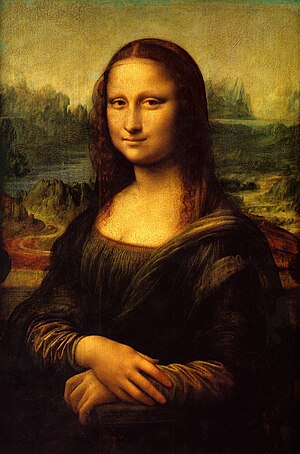Following are the famous images of mystery and enduring commitment:
 Arnolfini Wedding via Wikipedia
Arnolfini Wedding via WikipediaWhen students looked at these images, they marveled at the convincing illusionist techniques, and the absence of the artist in compositions. No one asked about the circumstances of the women in the paintings. Some found interesting articles about how da Vinci may have conceived his famous portrait from a self-portrait. Well, it's possible. And, it's not the first example of drag in Art History -- we can go back as far as ancient Egypt, when Queen Hatshepsut became pharoah. She took over the throne after the death of her pharoah husband Thutmose II, and donned the traditional masculine garb in accordance.
And what about the mysterious Italian figure who dared to meet the viewer's eye? Why would it be so scandalous? Could it be that it implied meeting desire? Yes. Furthermore, it's challenging because the woman is shown at the forefront of a seemingly endless terrain, due to atmospheric and linear perspective. This is significant for its disavowal of the tendency to limit Florentine and Italian women's public visibility. As noted by Dale Kent's summary of David Allen Brown's book, Virtue and Beauty:
In their portraits women appear framed in the windows of their houses. In 1610 a French traveler commented after a visit to Florence that "...women are more enclosed [here] than in any other part of Italy; they see the world only from the small openings in their windows...."
 |
| The Mona Lisa via Wikipedia |
Women artists today, such as Cuban artist, Ana Mendieta, and American artist, Francesca Woodman, examine surveillance and gender roles and myths. Blending power and subverting the object role, these are only two examples of artists who examine the fairly traditional means of representing women through visual images. Look at these two images and consider the act of looking.
This first work is one of my favorite images about the mirror as a symbol for female vanity and identity by Francesca Woodman. (You can check out more images here.)
 |
| Image courtesy of Research page via Steven Berkowitz Educational Pages. |
This second and final example by Ana Mendieta gives new meaning to our sense of the study of anatomy during Renaissance times, in which the Vitruvian Man was the quintessential "map" for humanist ideals. What does it mean in its new conceptualization?
 | ||
| Image courtesy of I <3 Photograph. |
